Ankh - Symbol of Life
The Ankh is the ancient Egyptian symbol for life (Hieroglyphic). It is one of the most potent symbols represented in Egyptian art, often forming a part of decorative motifs.

The ankh is an evolved form of, or associated with the Egyptian glyph for magical protection, sa. However, what the sign itself represents is often disputed. For example, some thought that it showed a sandal strap with the loop at the top forming the strap. If so, the symbolism is obscure and has found little real favor early on. However, this interpretation seems to have received some acceptance among modern writers. It would seem that the ancient Egyptians called that part of the sandal 'nkh (exact pronunciation unknown). Because this word was composed of the same consonants as the word "life", the sign to represent that particular part of the sandal, was also used to write the word "life".
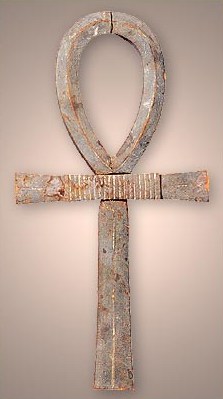
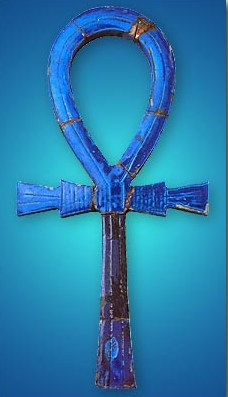
Left: 18th Dynasty ankh from the reign of Amenhotep II made of Wood;
Right: An early Ankh amulet made of Lapis Lazuli
Another theory holds that the ankh was symbolic of the sunrise, with the loop representing the Sun rising above the horizon, which is represented by the crossbar. The vertical section below the crossbar would then be the path of the sun.
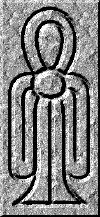
The "Knot of Isis"
Others felt it was associated with the tyet emblem, or the "knot of Isis". The thought was both were ties for ceremonial girdles. And some connected the ankh with the royal cartouche in which the king's name was written.
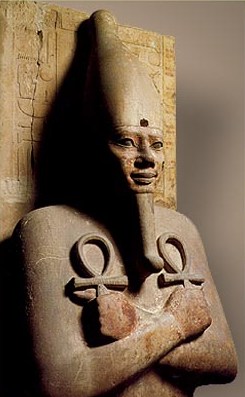
Osiris Pillar of Senusret I from the 12th Dynasty
Others have even identified it as a penis sheath. The presence of a design resembling a pubic triangle on one ankh of the new kingdom seems to allow for the idea that the sign may be a specifically sexual symbol. In fact, guides in Egypt today like to tell tourists that the circle at the top represents the female sexual organ, while the stump at the bottom the male organ and the crossed line, the children of the union. However, while this interpretation may have a long tradition, there is no scholarly research that would suggest such an exact meaning.
The ankh, on some temple walls in Upper Egypt, could also symbolize water in rituals of purification. Here, the king would stand between two gods, one of whom was usually Thoth, as they poured over him a stream of libations represented by ankhs.

The ancient gods of Egypt are often depicted as carrying ankh signs. We find Anqet, Ptah, Satet, Sobek, Tefnut, Osiris, Ra, Isis, Hathor, Anibus and many other gods often holding the ankh sign, along with a scepter, and in various tomb and temple reliefs, placing it in front of the king's face to symbolize the breath of eternal life.
During the Amarna period, the ankh sign was depicted being offered to Akhenaten and Nefertiti by the hands at the end of the rays descending from the sun disk, Aten. Therefore, the ankh sign is not only a symbol of worldly life, but of life in the netherworld. Therefore, we also find the dead being referred to as ankhu, and a term for a sarcophagus was neb-ankh, meaning possessor of life.
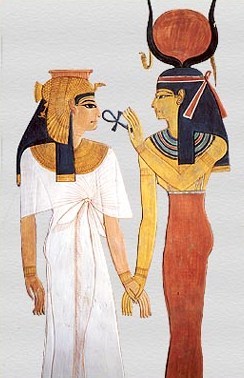
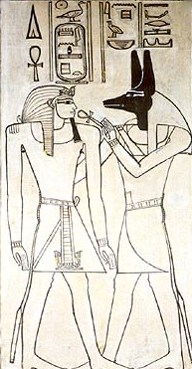
Left: Nefertari receives life from Isis; Right: Amenhotep II receives life from Anubis
It is at least interesting that the ankh word was used for mirrors from at least the Middle Kingdom onward, and that indeed, many mirrors were shaped in the form of an ankh sign. Life and death mirror each other, and in any number of ancient religions, mirrors were used for purposes of divination.
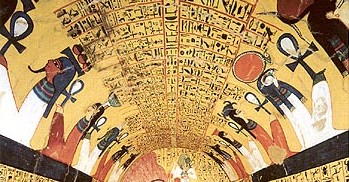
Hall of Ankhs
The ankh sign in ancient Egypt has transcended illiteracy, being comprehensible to even those who could not read. It is widely used in temples, on obelisks, and in carvings seen by the public. The ankh has even been used as a craftsman's mark on pottery vessels.

Egypt
 Free Forum Hosting
Free Forum Hosting